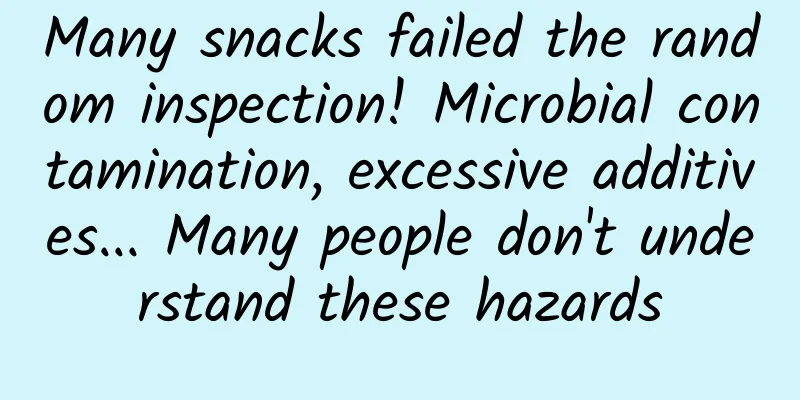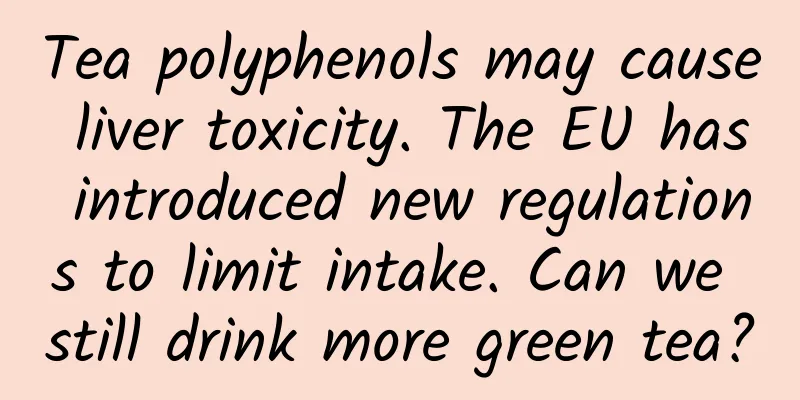Many snacks failed the random inspection! Microbial contamination, excessive additives... Many people don't understand these hazards

|
Expert of this article: Pa Lize, Chief Physician of Nutrition, Science Popularization Committee Member of Chinese Nutrition Society When buying snacks, people will definitely check the color, aroma, packaging, production date and shelf life, but do you pay attention to food additives? Recently, the State Administration for Market Regulation reported that 13 batches of food samples failed to meet the standards, including microbial contamination, excessive use of food additives or excessive amounts. Screenshot from the State Administration for Market Regulation What harm will eating such problematic foods cause to our bodies? How should we choose snacks in our daily lives? Why does food become contaminated by microorganisms? Most microorganisms have strong ecological adaptability and usually coexist widely in environmental media such as water, air, and soil that humans rely on for survival. Although not all microorganisms are harmful to humans, there are many types of harmful microorganisms and they are more harmful. There is a risk of contamination by harmful bacteria and bacterial toxins, fungi and mycotoxins in many links such as food raw materials and processing. If food is contaminated by microorganisms and their metabolites (toxins) during processing, packaging, storage, transportation, sales and consumption and is not identified and handled in time, it is easy to cause food safety incidents. What are the dangers of eating food contaminated by microorganisms? When eating food contaminated by microorganisms, pathogenic bacteria will infect human tissues and multiply in them. Some microorganisms will produce toxic chemicals during the process of reproduction and metabolism. After being absorbed by human tissues, they will cause varying degrees of harm to the body: from mild headaches and gastrointestinal discomfort to more serious vomiting, diarrhea, hemolysis, paralysis and even death. Even relatively mild microbial contamination may cause massive destruction, decomposition and loss of food's proteins, fats, carbohydrates, vitamins and inorganic salts, seriously degrading the food's nutritional value. Copyright image, no permission to reprint Microbial contamination is an important cause of foodborne diseases in humans, and the food safety problems caused by it account for almost half of the total. According to my country's annual foodborne disease monitoring data, except for accidents, most of them are caused by pathogenic microorganisms. Therefore, in order to ensure food safety, countries around the world will focus on detecting harmful microorganisms in food as a routine food safety supervision work. Why use food additives? The definitions, categories and varieties of additives vary from country to country. my country's definition of food additives is: Food additives refer to artificial or natural substances added to food to improve food quality and color, aroma and taste, as well as for the needs of preservation, freshness and processing technology. The purposes of food manufacturers around the world in using additives can be summarized as: to improve the color, aroma, taste, shape and structure of processed foods, to simplify the process, to unify the quality of finished products, to increase food production efficiency, to prevent food spoilage, to reduce packaging and transportation costs, to extend the shelf life (shelf life of food), and to maintain and increase the nutritional content of food. Precisely because additives have such advantages and characteristics, it is difficult to avoid the problem of excessive or excessive use of food additives during food production and processing. What are the dangers of eating foods with excessive amounts of additives? The safety evaluation of food additives must go through the process of reviewing the formula → reviewing the production process → conducting toxicology experiments (to determine acute and chronic toxicity and teratogenic and carcinogenic effects). It is also necessary to collect as much reaction data as possible from different populations exposed to the substance and then calculate the possible human intake. Finally, the safety factor method is used to determine the consumption limit and scope of application. Copyright image, no permission to reprint There are 23 categories and more than 2,000 varieties of food additives approved by my country through safety evaluation. For details, please refer to the National Food Safety Standard - Standard for the Use of Food Additives (GB 2760). As can be seen from the above, most healthy people do not need to worry about the safety of food additives. However, if additives are used in foods for specific consumer groups, fresh ingredients that do not need to extend the shelf life, or foods that do not need to improve quality, it may lead to excessive consumption of additives and cause health hazards. For example, if additives are present in snacks for children, foods for pregnant women and nursing mothers, freshly squeezed juices, freshly cut ready-to-eat ingredients, hot pot soups and other foods, it will cause health hazards to children whose liver and kidney functions are not fully developed, pregnant women and nursing mothers at special physiological stages, and the elderly and infirm, and people should be highly vigilant. How to choose snacks? Snacks are foods consumed between meals and outside of the three meals. They have important health benefits for children, adolescents, and the elderly whose digestive and absorption functions are reduced to a certain extent. They can make up for the lack of food intake during the three meals, meet physiological needs, and prevent nutrient deficiencies. However, if you fail to choose snacks correctly, not only will you consume too much energy and increase the risk of being overweight or obese, but you will also be endangered by excessive intake of various additives. Therefore, it is very important to learn how to choose snacks and determine the "level" of snacks. 1 The most intimate snack Foods that can be consumed in moderate amounts daily These foods are natural, unprocessed, rich in nutrients, and low in energy, such as all kinds of fresh fruits, yogurt, boiled beans, nuts, steamed potatoes, etc. Copyright image, no permission to reprint 2 Relationship is OK snacks Foods that can be eaten in moderation 1-2 times a week These foods are processed and contain a certain amount of salt, sugar and fat, such as cheese, fish fillets, seaweed, dried fruits and plums, wafer biscuits, soda crackers, whole wheat crackers and so on. 3 Snacks to avoid Foods that should be consumed no more than 1-2 times a month These foods are characterized by complex processing methods. Although they taste good and are beautifully packaged, they are high in fat, salt and sugar. Try to eat less chocolate candies, cream cakes, potato chips, spicy strips, cookies and other foods, as well as sugary drinks such as pearl milk tea and cola. The cover and watermarked pictures of this article are from the copyright gallery. The pictures are not authorized for reprinting. |
<<: The Mystery of Gigantopithecus and Humans in Lingnan's Prehistoric History
>>: How far are we from the virtual world in "The Matrix"?
Recommend
What should I do if the reputation score of products sold on Douyin is low? How to improve the reputation of Douyin store?
This article mainly introduces what to do if the ...
Why does a fever come back a few days after it subsided? Doctors remind you!
Recently, many people have gradually recovered, b...
Summary of information flow advertising optimization techniques!
1: Bid If the account is old and new products are...
What is the essence of “super user thinking” in Luo Zhenyu’s 2017 New Year’s Eve speech?
For super users, spring is here. But ordinary use...
In just a few days, 2 dead, 8 injured, 9 trapped! Safety first during travel season!
On July 22, a tourist was playing the "Start...
Xiaomi is reluctant to build cars, and the fact that the “diaosi” group cannot afford them is not the only reason
Faced with the unprecedented change in electric v...
"Wukong" these seven years
Today, the "Wukong" dark matter particl...
Should we find a new way or stick to tradition? What is the way out for online variety shows?
In recent years, celebrity reality shows have bec...
Why do humans have hair?
I believe you have already discovered that humans...
Bloomberg: Chinese-made cars will account for nearly 10% of South Africa's total auto sales in 2024
Bloomberg News reported that Trump wants to shut ...
An event planning and execution form template
one Over the years of work, I have participated i...
Solid info! How to realize the monetization of the three major online advertising and its development trend
The current profit models of the Internet industr...
More than 80 ducks were eaten for lunch! Why is the roast duck in the Olympic Village so popular?
Expert of this article: Pa Lize, chief physician ...
Most popular iPhone selection: iPhone 7 only ranked sixth
The sales of iPhone 7/7 Plus were better than tho...
Case solved! Doctor says eyelashes that fell into the eye are still hidden in the eye
June 6 is the National Eye Care Day. Eyes are oft...









